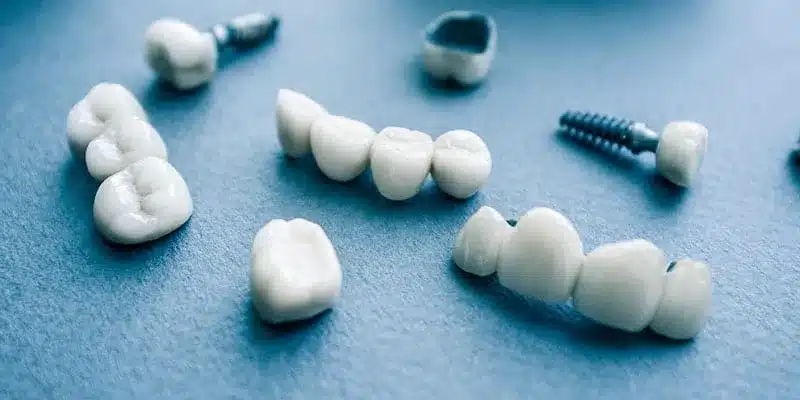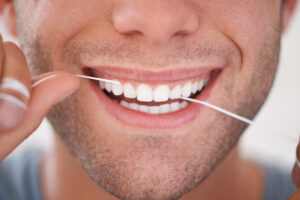- What is restorative dentistry?
- What are the benefits of dental restoration?
- What are the restorative dentistry procedures?
- Can restorative dentistry be used in conjunction with other treatments?
At Yonge Eglinton Dental in Toronto, we take pride in helping our patients have a beautiful, healthy smile they can be proud of. In most cases, our patients achieve this through brushing twice per day, flossing before bed, and coming into our office for regular dental checkups. However, teeth can become damaged due to infection, disease, or injury, in which case there are several procedures that can be done to return teeth to their normal working function. This is what’s known as restorative dentistry.
What is restorative dentistry?
Restorative dentistry refers to dental procedures that restore the functionality of the mouth. This includes repairing damaged teeth or replacing ones that have fallen or been knocked out, which can affect the ability to bite, chew, or speak properly.
These procedures, which include installing dental implants, fillings, and crowns are part of the normal preventative and corrective steps practiced by most dentists, so there won’t be any need for you to see a specialist.
Unlike cosmetic dentistry, which primarily focuses on the aesthetics of your teeth, restorative dentistry is used to keep your mouth healthy and functional.
What are the benefits of dental restoration?
After restorative dentistry or also known as dental restoration is performed, the patients’ natural teeth will be kept, or replaced with teeth that look, feel, and act like real teeth. This will eliminate any problems you had speaking or chewing as a result of damage or disease.
Restored teeth also help keep your adjacent teeth spaced correctly, giving you back a renewed, refreshed smile you can be proud of!
What are the restorative dentistry procedures?
When you need restorative dentistry, your dentist will be able to offer you several options for your particular situation:
- Dental fillings
Dental fillings top the list of the most common dental restorative procedures. Dentists use fillings to replace the decayed parts of your teeth that have resulted in dental caries (commonly known as cavities). Fillings can be made of amalgam, porcelain, gold, silver, or other materials. They’re also used to even out tooth surfaces to improve biting and chewing. Once in place, most patients will notice a significant improvement or the complete eradication of the discomfort they were feeling before the procedure.
- Dental bridges
Your dentist may recommend a dental bridge to replace one or more teeth. This procedure involves placing a false tooth, made of ceramic or other durable materials, to fill the space where your natural tooth was. Dental bridges help eliminate any gaps in your smile, restores a functional bite, preserves your speech, and stops other teeth from shifting into the open space. They can last a lifetime if you maintain optimal oral hygiene and visit your dentist for routine check-ups.
- Dental crowns
If you have a damaged, decayed, or cracked tooth, a dental crown can help restore your tooth’s proper size, shape, and strength. In simple terms, crowns are hollow caps that are created in the shape of your tooth and cemented in place. Crowns can be made from many different materials, including ceramic or gold, but many patients opt for porcelain crowns fused to metal for long-lasting durability and a natural appearance that blends well with their natural teeth.
- Dental implants
Dental implants are another effective way to replace teeth that have fallen out due to gum (periodontal) disease, tooth decay, bone loss, fracture, or infection. It’s also an excellent alternative to dental bridges when teeth adjacent to the missing tooth aren’t strong enough to support the bridge. Dental implants are installed directly into the jawbone, giving them greater longevity than bridges or dentures. Once the implant is in place, it looks, feels, and acts like a regular tooth that you can brush and floss like you normally would your other teeth.
- Dental Bonding
Are one or more of your teeth chipped, cracked, or discoloured? Dental bonding can help. This easy, painless procedure involves shaping and bonding a composite resin composed of tough, durable plastic to the tooth. Dental bonding restores damaged teeth to a more natural shape and/or colour, without the need for a long recovery time or multiple visits to the dentist.
- Inlays/Onlays
These types of restorative dental appliances are used when the tooth is too damaged or decayed for a filling, but the tooth’s structure isn’t sufficiently harmed to warrant a dental crown. Inlays and onlays help to preserve as much of your natural tooth as possible and will last longer than direct fillings, although they require multiple visits to your dentist to complete.
- Veneers
Ever wonder why your favourite celebrities have perfectly pearly-white smiles? Chances are they’ve had porcelain shells called veneers placed onto their teeth. Although veneers are often associated with cosmetic dentistry as they cover up stained or discoloured teeth, they can also be used as a restorative measure for broken, chipped, crooked, or misshapen teeth.
Can restorative dentistry be used in conjunction with other treatments?
In many cases, restorative dentistry and other procedures are used together to treat dental issues. For example:
- Teeth whitening:
This involves bleaching the surfaces of your natural enamel teeth to remove any stains or discolouring. Teeth whitening doesn’t work on implants, fillings, crowns, or veneers because they are not made of tooth structure and are unaffected by the whitening procedure. For this reason, whitening is often recommended prior to completing restorative dentistry procedures in highly visible areas of the mouth (e.g., your front teeth).
- Complete or partial dentures
Missing teeth or damaged gum tissue can cause you to have difficulties when speaking, chewing, or smiling. Natural-looking complete or partial dentures are an affordable option that restores your teeth’s normal appearance and functionality. Complete dentures replace entire upper or lower rows of teeth, while partial dentures clasp into neighbouring teeth to replace several adjacent teeth. Unlike dental bridges and implants, dentures are easily removed for cleaning.
- Tooth extractions
At Yonge Eglinton Dental, we do everything we can to save at least a portion of a diseased or damaged tooth. Tooth extractions are performed as a last resort when the tooth is beyond saving. The good news is that we can employ other tooth restoration options, such as bridges and implants, to fill the gap in your smile and return your teeth to their natural working order.
- Root Canals (Endodontics)
In cases where a tooth is so badly decayed that a filling won’t be enough to fix it, your dentist might recommend a root canal. This procedure helps to clean decay from the root of the affected tooth that causes painful toothaches. The empty root canal is then filled with a rubber compound and sealed shut before a crown is placed on top to restore the tooth’s appearance and strength.
- Contouring
Contouring is often used with dental bonding to fill in chips in your teeth. This procedure can also involve altering a tooth’s position, width, length, or shape, making it an ideal solution for people with crooked teeth, as well as teeth that overlap, are of different lengths, or positioned at undesired angles.
Be sure to ask your dentist about the many restorative dentistry procedures that will help to get the smile you’ve always dreamed of!
Considering One of These 7 Restorative Dentistry Procedures? Ask us at Yonge Eglinton Dental in Toronto
At Yonge Eglinton Dental, it’s always time to smile! Talk to us about restorative dentistry procedures that will help your teeth and gums look, feel, and work their best!
Give us a call today at 416-932-2222 or book an appointment online. We look forward to seeing you!
Concerned about visiting the dentist? Read about how we protect the health and safety of our patients and staff so your family can seek proper dental care with peace of mind.








